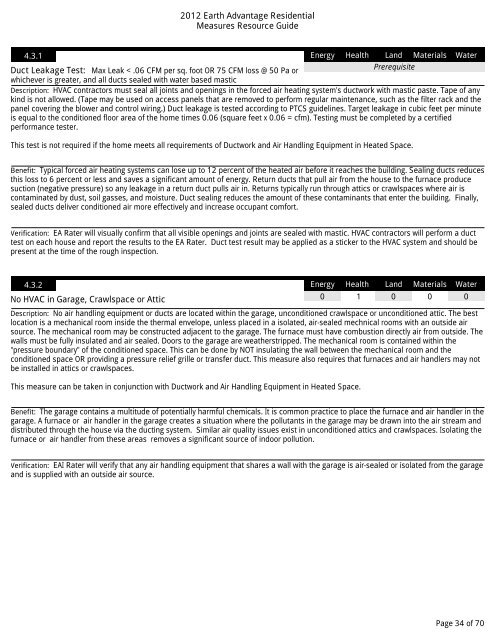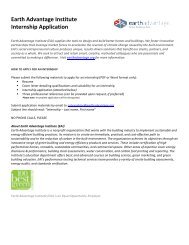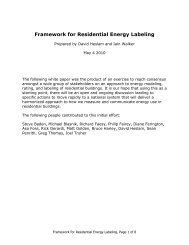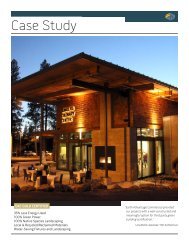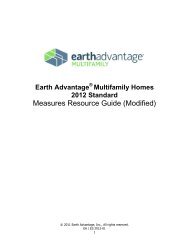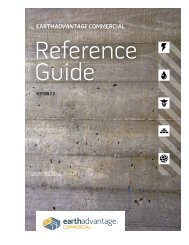EA New Homes Measures Guide - Earth Advantage
EA New Homes Measures Guide - Earth Advantage
EA New Homes Measures Guide - Earth Advantage
Create successful ePaper yourself
Turn your PDF publications into a flip-book with our unique Google optimized e-Paper software.
2012 <strong>Earth</strong> <strong>Advantage</strong> Residential<br />
<strong>Measures</strong> Resource <strong>Guide</strong><br />
4.3.1<br />
Energy Health Land Materials Water<br />
Duct Leakage Test: Max Leak < .06 CFM per sq. foot OR 75 CFM loss @ 50 Pa or<br />
Prerequisite<br />
whichever is greater, and all ducts sealed with water based mastic<br />
Description: HVAC contractors must seal all joints and openings in the forced air heating system's ductwork with mastic paste. Tape of any<br />
kind is not allowed. (Tape may be used on access panels that are removed to perform regular maintenance, such as the filter rack and the<br />
panel covering the blower and control wiring.) Duct leakage is tested according to PTCS guidelines. Target leakage in cubic feet per minute<br />
is equal to the conditioned floor area of the home times 0.06 (square feet x 0.06 = cfm). Testing must be completed by a certified<br />
performance tester. <br />
<br />
This test is not required if the home meets all requirements of Ductwork and Air Handling Equipment in Heated Space.<br />
Benefit: Typical forced air heating systems can lose up to 12 percent of the heated air before it reaches the building. Sealing ducts reduces<br />
this loss to 6 percent or less and saves a significant amount of energy. Return ducts that pull air from the house to the furnace produce<br />
suction (negative pressure) so any leakage in a return duct pulls air in. Returns typically run through attics or crawlspaces where air is<br />
contaminated by dust, soil gasses, and moisture. Duct sealing reduces the amount of these contaminants that enter the building. Finally,<br />
sealed ducts deliver conditioned air more effectively and increase occupant comfort.<br />
Verification: <strong>EA</strong> Rater will visually confirm that all visible openings and joints are sealed with mastic. HVAC contractors will perform a duct<br />
test on each house and report the results to the <strong>EA</strong> Rater. Duct test result may be applied as a sticker to the HVAC system and should be<br />
present at the time of the rough inspection.<br />
4.3.2<br />
No HVAC in Garage, Crawlspace or Attic<br />
Energy<br />
Materials<br />
Water<br />
0 1 0 0 0<br />
Description: No air handling equipment or ducts are located within the garage, unconditioned crawlspace or unconditioned attic. The best<br />
location is a mechanical room inside the thermal envelope, unless placed in a isolated, air-sealed mechnical rooms with an outside air<br />
source. The mechanical room may be constructed adjacent to the garage. The furnace must have combustion directly air from outside. The<br />
walls must be fully insulated and air sealed. Doors to the garage are weatherstripped. The mechanical room is contained within the<br />
"pressure boundary" of the conditioned space. This can be done by NOT insulating the wall between the mechanical room and the<br />
conditioned space OR providing a pressure relief grille or transfer duct. This measure also requires that furnaces and air handlers may not<br />
be installed in attics or crawlspaces. <br />
<br />
This measure can be taken in conjunction with Ductwork and Air Handling Equipment in Heated Space.<br />
Health<br />
Land<br />
Benefit: The garage contains a multitude of potentially harmful chemicals. It is common practice to place the furnace and air handler in the<br />
garage. A furnace or air handler in the garage creates a situation where the pollutants in the garage may be drawn into the air stream and<br />
distributed through the house via the ducting system. Similar air quality issues exist in unconditioned attics and crawlspaces. Isolating the<br />
furnace or air handler from these areas removes a significant source of indoor pollution.<br />
Verification: <strong>EA</strong>I Rater will verify that any air handling equipment that shares a wall with the garage is air-sealed or isolated from the garage<br />
and is supplied with an outside air source.<br />
Page 34 of 70


